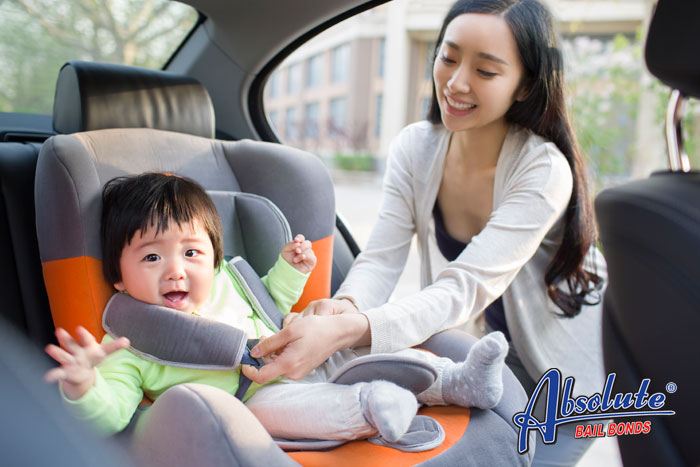
California’s Car Seat Laws
Every parent who has an infant knows that they’re supposed to have a car seat installed in their vehicle. They even know that it’s state law. What some parents don’t know is how important the car seat is and the consequences of having a car seat that doesn’t meet current safety standards, that isn’t properly installed, or that isn’t properly fitted to their child.
According to Car Buyers Guide, “in a recent study, the RSA inspected 5000 child seat installations from the public and found that over 4000 of them needed adjustments of some kind to ensure optimum safety.”
California’s lawmakers used Vehicle Code 27360 VC to address the issue of car seats. The law clearly states that:
- Children under the age of 2 must be properly restrained in a rear-facing car seat
- Children under the age of 8 must ride in the back seat and be safely restrained in an age/size appropriate safety seat.
- The child must be secured into the safety car seat in a manner that complies with both height and weight limits that are to be specified by the car seat manufacturer.
According to the Mayo Clinic, the most common mistakes parents make when it comes to the car seats they’re using include:
- Purchasing a used car seat without making sure it isn’t more than 6 years old, hasn’t been involved in an accident, hasn’t been subject to a recall, and has no indications of damage or structural problems that could endanger a child.
- Failing to properly install the car seat
- Failing to properly restrain the child before driving
- Reclining the car seat so that the child isn’t at the correct and most safe angle
- Switching their child to a forward-facing car seat before the child is ready
The first time a driver is ticketed for not following California’s car seat laws, they’ll be issued a ticket. $100 of that ticket pertains to not having the child properly restrained. Court fees and additional charges will also be added to the ticket. After that initial ticket, the fine connected to not properly restraining the child is $250.
In some cases, the ticket for not having a child properly restrained to a child seat is the least of the driver’s worries. In many situations, the driver will also face charges of negligence and child endangerment.
It doesn’t matter how big a rush you are in, always take the time to make sure your child is safe before you hit the road.

Child Endangerment in California
California’s lawmakers believe that adults have a moral and legal responsibility to protect children. Failing to do so can put you on the wrong side of the law.
The California Penal Code 273a PC deals with the issue of child endangerment.
The interesting thing about Penal Code 273a PC is that while it deals with child endangerment, it isn’t the same law that defines child abuse.
The idea behind child endangerment is that the episode is often a single episode. It doesn’t always involve a child getting hurt, but rather addresses the fact that a child, which according to the California legal system is anyone under the age of 18, could have been hurt or killed as a direct result of your actions. Getting behind the wheel and driving drunk while your passenger is a minor is a good example of a child endangerment case.
Additional examples of child endangerment include:
- Hiring the services of a babysitter who has an abusive past
- Exposing your child to a dangerous animal
- Failing to notice that your child is playing in the middle of a busy road
- Leaving a firearm laying around the house while a child is present
Many parents don’t realize that in extreme cases, failing to seek medical assistance for a child who is for an extremely sick or badly injured child can be considered child endangerment.
Just because you’ve been accused of child abuse and the case has gone to trial, it doesn’t mean you’ll be sent to jail.
In order to be convicted of child endangerment in California, the prosecutor has to effectively prove that you knew there was a chance that your actions (or lack of action) created a situation where the child was in danger.
Defenses that have been successfully used in child endangerment cases include:
- You couldn’t have known that the child was potentially in danger
- The child wasn’t your responsibility
- You were falsely accused (false accusations of child endangerment aren’t uncommon in cases that also involve a custody dispute)
- The endangerment was completely accidental
You’ll be surprised to learn that child endangerment is one of California’s wobbler laws. The details of the case determine if you’re charged/convicted of a misdemeanor or a felony.
If there was a chance that the situation could have resulted in death or extreme injuries to the child, you should expect the prosecutor to pursue felony child endangerment charges.
If you’re convicted, the potential consequences could include:
- A fine that doesn’t exceed $10,000
- Getting sentenced to anywhere from 2 to six years on a state prison
If it doesn’t appear that the child could have been severely injured or died as a result of your actions, the prosecutor will go after a misdemeanor charge.
If you’re convicted, you could:
- Be sentenced to up to one year in the county jail
- Be charged a fine that doesn’t exceed $1,000
The best way to avoid child endangerment charges in California is using common sense and avoid dangerous situations whenever possible.

